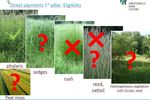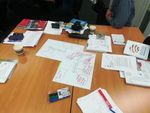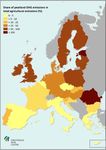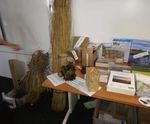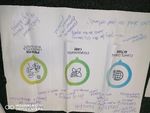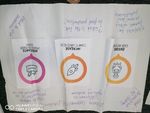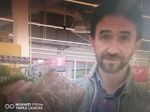Exchange of views on post 2020 CAP and its effect on farming on organic (peat) soils Report - MoorWissen
←
→
Page content transcription
If your browser does not render page correctly, please read the page content below
Exchange of views on post 2020 CAP and its effect on farming on organic (peat)
soils
Report
Compiled by Lea Appulo (WI-EA), Jan Peters and Franziska Tanneberger (both GMC)
Executive summary
As an activity foreseen under the REPEAT1 project, on 9th April 2019 Wetlands International European
Association together with Greifswald Mire Centre organised an exchange of views with EU actors on
post 2020 Common Agricultural Policy (CAP) and its effect on farming on wet organic (peat) soils called
paludiculture.
Paludiculture is the productive use of wet peatlands. First used by Hans Joosten (1998), paludiculture is
known as a land management technique that cultivate commercially interesting crops on wet or
rewetted peatlands under conditions that maintain the peat body, facilitate peat accumulation and
sustain the ecosystem services associated with natural peatlands. Unfortunately, this land use
technique is not well known by farmers and decision makers. Obstacles and counteracting incentives
exist in the current CAP, which are preventing farmers to go for it and the new proposal under
discussion needs improvements to allow such a practice.
The meeting aimed at building a common understanding of the importance of peatland rewetting to
reduce CO2 emissions, to inform about the concept and examples of paludiculture, to feed the current
policy discussions on the post 2020 CAP, and to inform policy makers how to support larger scale
implementation of paludiculture before the approval of the final amended legislation documents and
the CAP national strategic plans.
An overview of the new CAP legislative proposal and the state of play of the co-decision procedure was
presented by Zelie Peppiette and Olivier Diana from EC Directorate General Agriculture. The new
proposal2 presented on 1st June 2018 aims at increasing CAP’s environmental and climate ambition.
Among the nine specific objectives set up, three3 of them refer to the new green architecture of the
CAP. To achieve these objectives members states have to submit strategic plans after identifying needs
through a SWOT analysis and designing type of actions which will be approved by the European
Commission. New elements of the proposal include: a) enhanced conditionality: a new obligation
include preserving carbon-rich soils through protection of wetlands and peatlands; b) Eco-schemes, a
pillar I instrument which are voluntary for farmers and mandatory for Member States.
1
REPEAT - REstoration and prognosis of PEAT formation in fens - linking diversity in plant functional traits to soil biological and
biogeochemical processes, is the first project to systematically address fen peat formation using an interdisciplinary, multi-method and
multi-site approach across Europe. It is led by Warsaw University and funded by ERA-NET Cofunds BiodivERsA3. www.repeat-project.com
2 Proposal for a REGULATION OF THE EUROPEAN PARLIAMENT AND OF THE COUNCIL establishing rules on support for strategic plans to be
drawn up by Member States under the Common agricultural policy (CAP Strategic Plans) and financed by the European Agricultural
Guarantee Fund (EAGF) and by the European Agricultural Fund for Rural Development (EAFRD) and repealing Regulation (EU) No 1305/2013
of the European Parliament and of the Council and Regulation (EU) No 1307/2013 of the European Parliament and of the Council
COM/2018/392 final - 2018/0216 (COD)
31. Contribute to climate change mitigation and adaptation, as well as sustainable energy
2. Foster sustainable development and efficient management of natural resources such as water, soil and air
3. Contribute to the protection of biodiversity, enhance ecosystem services and preserve habitats and landscapes.The discussion is far to find an agreement, above all because of the European election held in May, EP
did not vote the dossier in plenary setting. The EP Committees of Environment and of Agriculture met
in April to approve the tabled amendments, among which a specific amendment n. 91 referring to
paludiculture was approved4. The new configuration of EP still needs to agree whether the dossier will
be voted in plenary or re-discussed from scratch. It will be decided in September 2019. The Romanian
Presidency advanced the work on the CAP but now it is up to the Finnish Presidency to try to come to
an agreement.
From decision making process, the discussion moved to a more scientific focus on peatlands and
paludiculture, starting with a video sent by Wiktor Kotowski, University of Warsaw, where he explained
the food-carbon footprint related to peat and the current destructive agricultural practices on peatland
with the products coming thereof.
Dr. Franziska Tanneberger, Greifswald Mire Centre, helped the audience to better understand that
peatlands in their natural state are unique and important natural ecosystems with high value for
biodiversity conservation, climate regulation and human welfare. They are wetlands with a waterlogged
organic soil layer (peat). Peatlands represent the world’s most effective carbon stores. Globally they
cover 3% of the land surface but they hold 20% of global soil carbon – two times more than all the
world’s forests biomass combined. When peatlands are drained for cultivation, they become net carbon
emitters instead of active carbon stores. European peatlands have been and are mainly drained for
agriculture, forestry and peat extraction. Paludiculture presents the necessary paradigm shift towards
sustainable regional economies with global climate benefits. Instead of draining them, peatlands are
kept productive under wet, peat-conserving conditions. It provides valuable ecosystem services that
are not (yet) paid, including reduction of GHG emissions, protection of ground- and surface water,
retention of water in the landscape and conservation of biodiversity. From a macroeconomic point of
view, stopping transfer payments to farms that operate on drained peatlands and shifting to farms that
put paludiculture into practice are therefore a very cost-effective way to fulfil international
commitments with respect to protecting climate, water and biodiversity.
Despite the cost-effectiveness of paludiculture, the current CAP as implemented by most Member
States discriminates crops suitable for cultivation on wet or rewetted peatlands (e.g. reed, cattails,
sedges and peat mosses) as not eligible for payments within the pillar I (Representatives from DG Agri
stressed that these crops can be regarded as eligible, and that there had been little interest by Member
Statues to clarify this question with DG Agri) . There are no incentives for farmers to raise water levels
and shift to more climate-friendly farming on organic soils. On the contrary, drainage-based agriculture
with adverse environmental impact for climate, water, soil and biodiversity is supported by CAP
subsidies. Additionally, greening requirements for the preservation of permanent grassland hinders the
cultivation of climate-smart paludiculture crops on nowadays deeply drained peaty grasslands
(Czybulka & Kölsch 2016)5. Jan Peters, Michael Succow Foundation, helped understanding what should
be improved in the new CAP and suggested key elements to be included: Overarching objectives have
to be set by the EU
➔ Paludiculture integrated into spatial planning and new CAP (Pillars I + II)
➔ Clear GHG emission reduction targets needed to fulfil Paris Agreement e.g. via strict GAEC 2
4
http://www.europarl.europa.eu/doceo/document/A-8-2019-0200_EN.html
5
Briefing Paper on the role of peatlands in the 2021 European Union’s Common Agriculture Policy (CAP), Compiled by the Greifswald Mire
Centre, March 2019➔ Clear targets for other goals (water quality, biodiversity etc.)
➔ Eligibility of paludiculture for CAP payments
➔ Paludi-crops (reed, cattail, peatmoss etc.) qualify as agricultural activity
➔ No cut of funds in 2nd pillar to allow for ambitious peatland agri-environmental schemes to
reach targets
➔ Flexibility for member states by national strategy plans to reach the goals can provide chances
for peatland-rich member states to create schemes in both pillars for paludiculture to fulfil
climate goals (e.g. EcoSchemes in 1st pillar, Agri-environmental Climate Schemes in 2nd pillar)
➔ This can help to adopt country-specific situation (environmental, socio-economic)
BUT: Exchange of experience between peatland-rich regions in Europe needed
BUT: Risk of low environmental and climate ambitions in member states
➔ Clear EU wide environmental policy targets need to be set
After getting the policy and scientific insights, two examples of farming on organic soil were given.
On one side, Alfred Smolczynski, reed cutter from Rozwarowo Marshes, Poland who managed to have
his reed farming recognised as CAP eligible practice, but he is now affected by import from China. On
the other Aldert van Weeren, Cattail farmer from the Netherlands working in Germany is struggling to
get his activity recognised as agricultural practice, but also to have ecosystem services from his activity
paid. Despite the differences, both of them are asking for better legal recognition of paludiculture and
its products, to allow farmers to apply it without incurring in fines and problems. They want also to be
protected by the EU against non-EU import.The future CAP: State of play and the role of peatlands in the green architecture presented by European Commission (DG AGRI) Zelie Peppiette, DG AGRI, set the scene by presenting what is new in the European Commission’s legislative proposals on the future of the CAP for the period after 2020. The main element of the new CAP is applying a result-based delivery model. Member States have to submit strategic plans in which they have to set targets and design interventions. These plans have to be linked to national planning tools from EU legislation, non-CAP legislation and strategies like climate change, water, biodiversity etc. and have to be approved by EC.
Olivier Diana, DG AGRI, presented the legislative proposal of EC, explaining the green architecture of
the CAP. Three specific objectives concerning environment and climate:
- Contribute to climate change mitigation and adaptation, as well as sustainable energy;
- Foster sustainable development and efficient management of natural resources such as water,
soil and air;- Contribute to the protection of biodiversity, enhance ecosystem services and preserve habitats
and landscapes.
Each Member State needs to submit a strategic plan to achieve CAP objectives. To develop the plan,
each member state will initially analyse the situation on its territory in terms of strengths, weaknesses,
opportunities and threats (SWOT) – as well as its related needs – in respect of these objectives. Based
on the SWOT analysis, it will set quantified targets against the objectives and design "interventions"
(types of action) for achieving them, based on an EU-level menu. Member States have substantial
flexibility to implement designed actions. EC will approve the plan when satisfied with the actions
selected by the Member States.
Conditionality, which replaces ‘greening’ and cross-compliance of the current CAP, sets the baseline for
more ambitious and sustainable agricultural commitments through the adoption of good farming
practices and standards by farmers. New elements are:
• Protection of wetlands and peatlands
• Water Framework Directive, Directive on Sustainable Use of Pesticides
• Use of Farm Sustainability Tool for Nutrients
Strengthened elements, e.g. from “crop diversification” (greening) to “crop rotation” (conditionality)
Conditionalities are specified in the form of standards for the Good Agricultural and Environmental
Condition (GAEC). The following GAECs influencing conservation and management (e.g. in
paludiculture) of wetlands and peatlands:
Climate change
GAEC 1: Maintenance of permanent grassland based on a ratio of permanent grassland in relation to
agricultural area
GAEC 2: Preservation of carbon rich soils such as peatlands and wetlands
Water
GAEC 4: Establishment of buffer strips along water courses
GAEC 5: Use of Farm Sustainability Tool for Nutrients
Soil
GAEC 7: No bare soil in most sensitive period
GAEC 8: Crop rotation: Crop rotation is the practice of alternating growing crops grown on a same
field or land in a planned pattern or sequence so as to break weed/pest and disease cycles and
improve soil fertility and control insects and diseases. Crops specific for crop rotation should be from
3 distinct families.
Biodiversity
GAEC 9: Minimum share of agricultural areas devoted to non-productive features or areas = 7%
Retention of landscape features = no destruction of hedges, trees, etc.
Ban on cutting hedges and trees during the bird breeding and rearing season 1 April – 1 July
GAEC 10: Ban on converting or ploughing permanent grassland in Natura 2000 sites
Beyond the basic standards of conditionality, EC proposes funding instruments for environmental
activities of land users in both pillars:
Pillar I:
▪ Eco-schemes – a new way of spending Pillar I funding on the environment and climate (i.e.
without co-financing)▪ Can be useful to design a scheme that is attractive to a larger number of farmers – and will help
achieve a higher level of ambition
▪ Go beyond the conditionality requirements
▪ Mandatory for Member States, voluntary for farmers
▪ Many target areas in which Member States has particular challenges (e.g. GHG emissions,
nitrates or biodiversity loss)
▪ Annual commitments and payments – can be useful feature
▪ Member States have flexibility to design content of eco-schemes
▪ …and flexibility over payment – possibility of incentives
▪ Environmental “top-ups” to basic income support; or compensation payments based on costs
incurred, income foregone
Pillar 2:
▪ Full range of relevant Pillar II support remains available
▪ Key relevant support types:
▪ Payments for management commitments (including agri-environment-climate
commitments)
▪ Payments to compensate for constraints (natural, or related to Natura 2000 / Water
Framework Directive)
▪ Support for investments, knowledge transfer, innovation, co-operation
▪ Ring fencing: Member States to spend at least 30% of EAFRD budget on interventions directly
targeted at environment and climate change (payments for Areas of Natural Constraints (ANC)
no longer included)
▪ “Negative list" for investment support (unsustainable irrigation & forestry)
Zelie Peppiette helped us understanding what is new in the draft report discussed in the European
Parliament. With regards to wetlands/peatlands and paludiculture, EP amended the EC proposal by
amending the Art.4 the definitions: Rewetted areas used for paludiculture as eligible area (amendment
91).In the CAP strategic plans, Member States have to pursue the CAP’s specific objectives among which d)
soil carbon sequestration; e) systems delivering multiple environmental benefits; f) supporting High
Nature Value farming systems are listed. Member States have to also include services to advise farmers
of CAP support on land and farm management (the compulsory coverage of these Farm Advisory
Services has been extended (art.13).
According to EP Agri committee, Members States should include specific practices in their list of
agricultural practices ex: “where applicable, appropriate maintenance of wetland and peatland” in art
65 on agri-environmental sustainable practices to get payments for. Another example of what it should
be included in the list of agricultural practices beneficial for the climate and the environment as
management commitment is: “appropriate protection of wetlands and organic soils”
The legislative proposal of EC introduced new standards of conditionality (annex 3), linking to current
cross-compliance and Greening requirements. GAEC 2 and GAEC 10 have been amended as follows:
GAEC2 “maintenance of wetland and peatland in sensitive areas of Natura 2000” and GAEC 10:
“appropriate protection of permanent grassland in Natura 2000 sites recognized as sensitive areas”.
The CAP foresees a new monitoring and evaluation framework to be included in the CAP strategic plans
and reported in the Annual Performance report.
Two roundtables6 on the green architecture of the CAP were organised in 2018 putting together
agricultural and environmental stakeholders to explore the potential to support both environmental
objectives and sustainable farming.
Food and Peatlands
Almost half the EU's land is farmed. This makes agriculture extremely important for the EU's natural
environment, and for the climate. Wiktor Kotowski, University of Warsaw, via video link from a
supermarket, explained the food-carbon footprint related to peat and the current destructive
agricultural practices on peatland with the products coming thereof. He shared key data:
6
https://ec.europa.eu/info/events/round-tables-green-architecture-cap-2018-nov-12_en- Globally peatlands emit 2 Gt CO2 per year = 5%
of anthropogenic GHG emissions. Most is due to
agricultural drainage for food production and peat
extraction for agriculture and horticulture
- 1 liter of milk produced on peatland is
equivalent to an additional 2 kg CO2 emissions
- 1 kg condensed milk or cream is equivalent to
an additional 50 kg CO2 emissions
- 1 kg of butter is equivalent to an additional
100 kg CO2 emissions
- 1 kg of cheese produces 40-50 kg CO2
emissions
- Vegetables are grown in greenhouses and
nearly all are grown on peat coming from extracted peatlands, even from prior pristine
peatlands in the Baltic states, Canada or Belarus
- Pots of vegetables and flowers contain pure peat
- Flowers you buy are most often grown on drained peatland
- Majority of potting soil we use contains high proportion of peat
- Chocolate is made with palm oil produced on drained tropical peatlands
It is good to have a more environmental and climate friendly CAP, but we should avoid to use drained
peatlands for food production and other activities. “If you want to use peatlands, use them wet”, said
Hans Joosten, Greifswald Mire Centre.
➔ A shift to 'wet' agriculture (paludiculture) on organic (peat) soils is needed to reach the EU's
climate protection goals. Interestingly, such shift would provide plenty of additional ecosystem
services to society.
Paludiculture - showing environmental damage of drainage, environmental
benefits of paludiculture, land use opportunities
Peatlands occur in almost every country of the world, covering 3% of the global land surface. According
to IPCC, organic soils include i.a. land with a peat layer at the surface, explained Franziska Tanneberger,
Director of Greifswald Mire Centre, Germany. Peat accumulates when soil is permanently waterlogged
and died-off plant remains do not completely decompose. It contains a large proportion of organic
carbon. On European scale, peat soils make up 21% of Ireland and up 26% of Finland.
Drainage allows oxygen to enter the soil, leading to microbial decomposition of the peat and thereby
emission of substantial amounts of CO2 and N2O. Further negative consequences of drainage are
mobilisation and discharge of nutrients to ground- and surface water, and soil subsidence (1-2 cm
yearly) which results in increasing drainage costs, higher flooding risks and -ultimately- to loss of
productive land. Over centuries, European peatlands have been drained for agriculture, forestry and
peat extraction. For example, in Ireland 82% of peat soil is drained and in Finland 61% is drained. Thenegative consequences of this use
become more and more obvious.
When peatlands are drained, they
become net greenhouse gas (GHG)
emitters, much higher in comparison to
agriculture on mineral soils. The deeper
peatlands are drained, the more GHGs
are emitted. From a hectare of
degraded soil, roughly 30-40 tonnes of
GHG emissions a year are released. In
the brown countries in the figure, we
have 50 % of total agricultural
emissions from drained peatlands.
How is it possible that this problem
(emission from peatlands, subsidence)
has been overlooked for such a long
time?
Two main reasons are: 1) peatlands are
very little recognised, experts called it
as “cinderella syndrome”, 2)
agriculture in Europe comes from semi-
desert/ dry regions. For millennia, the
paradigm was that productive land
must be dry and regularly ploughed.
Solutions: Peat is preserved at ground
water levels close to surface so raising
water levels stop subsidence and CO2 emissions.
Paludiculture presents the necessary paradigm shift towards sustainable peatland use with global
climate benefits. Paludiculture is the wet alternative to drainage based land use on peatlands. The word
comes from the Latin “palus“ – swamp and means the use of wet peatlands which combines the
production function with the provision of essential ecosystem services. Instead of draining them,
peatlands are kept productive under wet, peat-conserving conditions. It mitigates climate change and
helps adapt to a changing climate.
Additional ecosystem services are: reduced nutrient run-off = water purification; decreased
evapotranspiration = landscape cooling; increased flood protection; Increased groundwater storage
and often increased biodiversity.
Paludiculture products7 can be used for several purposes, see table below.
7
Paludiculture briefing , GMCType of crop Purposes
Reeds canary grass (Phalaris arundinacea) for combustion, biogas
Common reed (Phragmites australis) for construction materials and energy
Sedges (Carex spp.) for energy (combustion, biogas), fodder and
litter
Cattail (Typha spp.) for construction materials, fodder, energy
(biogas)
The additional benefit of Typha is that it takes up
much more N and P and can be used for
purification of polluted sewage water.
Black alder (Alnus glutinosa) for carpentry, interior fittings, and furniture and
energy cultivation
Peatmoss (Sphagnum spp.) For horticultural substrate
The Database of Potential Paludiculture Plants (DPPP)8 collects information on useful wetland plants in
order to catalogue existing and identify new options for paludiculture. Currently, over 1.100 species
have been recorded and assessed for their paludiculture potential. More than 200 species seem
promising for commercial paludiculture. They can be grown at high water levels, preserving the peat
body, and there is a market demand for the products they provide.
8
https://greifswaldmoor.de/dppp-109.htmlIs Europe ready for paludiculture? Implications of the EU policy framework with
special focus on CAP
Peatlands relate to many EU policy frameworks (water, biodiversity, climate) especially to the
agricultural field (CAP), showed Jan Peters, Michael Succow Foundation, partner in the Greifswald Mire
Centre.
Reasons why there is no large-scale implementation of paludiculture are due to socio-economic
challenges such as resistance to the break of the tradition of draining peatlands. Making peatlands wet
is difficult as landownership is fragmented and convincing all landowners in an area to participate is
difficult.
➔ Solutions could include raising awareness on importance of preserving peat soils, creating
advisory services for farmers, working with land consolidation and regional corporations,
bringing the different stakeholders together to create clear inclusive area specific strategies,
safeguarding biodiversity.
CAP is main driver of peatland degradation due to payments for drainage-based agriculture as direct
payments counteract major policy targets (climate, water, biodiversity etc.). For instance in Germany,
farmers receives € 300 Mio./yr. CAP direct payments (pillar I) for drained peatland agriculture, which
causes € 2.8 - 8.6 Bn./yr. long-term climate damage, due to CO2 released.
➔ Solutions could be to phase-out CAP funding for drainage-based peatland utilization
➔ Set clear EU-wide environmental policy targets and Monitoring, Reporting and Validation
(MRV) schemesConcerning CAP Pillar I, it is an obstacle for paludiculture because farmers can lose direct payments
after land use changes and certain paludi-crops such as peat mosses are not regarded as „agricultural
crops“. This creates uncertainty whether they will receive the direct payment
For instance, Phalaris being considered as grassland species receives payment. Sedge is problematic.
Rush not receiving, reed and cattail very much depends on the Member State’s payment agency’s
decisions. For peat mosses is the same, farmers have no certainty to receive direct payments.
What is needed:
➔ Paludiculture qualifies as agricultural activity, paludi-crops are regarded as agricultural cultures
➔ Eligibility of paludicultures as “eco-schemes” (Pillar I)
Under current CAP, strict permanent grassland protection hampers conversion of grassland to wet
crops (“Greening”), Weak “Cross Compliance” (GAEC standard 6 „Maintenance of soil organic matter“)
and uncertainty and discrimination frustrate interested farmers.
➔ Clear standards and safeguards for peatlands
➔ Consistent use of proposed GAEC 2: “Appropriate protection of wetland and peatland” in
(climate) “Conditionality for climate change“
The amendment 7179 of the Agri Committee of EP ask that GAEC 2 refers to area located in Natura
2000 sites. This is an issue because many deeply drained peatlands are located outside Natura 2000
sites.
➔ GAEC 2: “Appropriate protection of wetland and peatland” should also apply to area outside
Natura 2000 sites
9
https://www.europarl.europa.eu/doceo/document/A-8-2019-0200_EN.htmlPillar II: Only voluntary measures can lead to low acceptance if obligations are ambitious
Agri-environmental climate schemes (AES) have been mainly used to stimulate low-intensity fen
grasslands management, focusing more on biodiversity benefits than on climate action. In the future
to allow farmers to apply AES benefitting peatlands it is needed that:
➔ Compensation through economic incentives for conversion
➔ Remuneration of ecosystem services: additional income + long-term perspective (15-20 years)
➔ Efficient monitoring system needed (MRV e.g. for GHG)
➔
Farmers’ experience
To conclude the set of presentations
moving from policy to science, we included
the practice with two farmers sharing their
experience with paludiculture in two
different approaches: On one side Alfred
Smolczynski from Poland who succeeded in
having his activities recognised as an
agricultural practice and subsidized, on the
other side Aldert van Weeren struggling for
the recognition of cattail as agricultural
product to access CAP payments in
Germany and The Netherlands.
CASE 1: REED farming in Poland
Alfred Smolczynski, reed cutter from Rozwarowo Marshes, Poland
In a peatland area in NW Poland, with a traditional history of family farming in collaboration with local
communities, they are harvesting reed, which can be used as insulation in housing and roofs. Their type
of farming got noticed and questioned whether good or not for nature and how to be classified. A
commission was set up to check whether their activity on marshes was beneficial for environment. In
2001 it was agreed that they could keep harvesting, but still with monitoring. When Poland entered EU,
it was difficult to understand how to pay this type of practice. They went with local farmers to the
Agricultural ministry to help subsidise their type of agriculture that was beneficial to nature. It is called
“complementary payment”.
“It is time for each country in EU to discuss about wetlands and their special protection.”
However financial stability which has been stable since now is threatened by competition with Chinese
imports of reeds
“EU should make framed schedule for reed and come up with new ideas to finance this.”CASE STUDY 2: CATTAIL – The Netherlands
Aldert van Weeren, landscape architect – new Cattail farmer
Aldert is trying to grow cattail on only 6 hectares of land. There are machineries for wetlands. Some
are new. He is suggesting of growing cattail in constructed wetlands, which has many benefits:
Cattail can be used for different purposes, among which biogas production. The amount grown from 1
hectare of cattail is 5 times the amount of biomass harvested from woodlands. He has used cattail as
insulation material for his house. This bioproduct is easy to make. He showed also a sauna completely
made of typha, super insulated.
Van Weeren stressed the following actions to make cattail farming possible:
- Use planning systems to make paludiculture
work and paludiculture strategy involves using no
fertiliser;
- Look for places to rewet from a strategical
point of view should involve places such as buffer zones
of nature reserves to reduce nutrient inflow or weakly
managed reserves to create ecological bridges;
- By rewetting peatlands, farmers should be
paid for the ecosystem services they contribute to, like
water cleaning, biodiversity protection. Rewetting and
growing cattail is contributing to produce bioproducts
that can be used as income source for farmers.
Aldert is encountering a big problem, because in 100 square meters of his land, he has planted cattail
as crop and unconsciously created a protected habitat. Current legislations requires now special
permission from the local conservation agency for entering and harvesting. Modification is needed to
allow for agricultural practice on such lands.Discussion with the audience
Zelie Peppiette (DG AGRI) facilitated the session with the audience by asking to share their
understanding on what paludiculture is and how to link it with the nine objectives of the CAP.
Messages collected after the participatory exercise:
➔ Paludiculture means environmental + climate benefits
➔ Also economic benefits + bio based products (bio-economy)
➔ CAP framework to be adapted to paludiculture
➔ Positive changes in the proposal, but more to be done to secure paludiculture options in the
final text to be approved in EP
➔ Obstacles have to be reduced
➔ Improvement in the text need to be locked up
➔ Recognition of paludiculture crops and land use needed in reset CAP
➔ Is the crop or land use of paludiculture eligible? Not on food list crop. Currently some crops
(maize) used for biogas
➔ Plants lists – clarification/extension for paludi-crops needed
➔ Sustainable growing media – potential for paludiculture
➔ CAP: restoration/ preservation
- Are other wetlands (not peat) converted to croplands?
- Demand for reed – import from China
- Relation food protection – diversify strategy
➔ Needs: awareness raising and knowledge sharingList of PARTICIPANTS
Name and Surname Organization
1 Lea Appulo Wetlands International EA
2 Cy Griffin Wetlands International EA
3 Jan Peters Michael Succow Foundation / Greifswald Mire
Centre
4 Franziska Tanneberger Greifswald University / Greifswald Mire Centre
5 Aldert van Weeren Farmer
6 Alfred Smolczynski Farmer
7 Symon Smolczynski Farmer
8 Cecilia Luetgebrune Growing Media Europe AIBSL
9 Svetlana Chovancova EC DG ENV
10 Zelie Peppiette European Commission
11 Olivier Maes European Commission - DG ENV
12 Emmanuel Petel DG AGRI EU commission
13 Karolina Fabianova European Committee of the Regions
14 Olivier DIANA European Commission - DG AGRI
15 Nicola DI VIRGILIO EC DG AGRI
16 Katja Klasinc European Commission RDT
17 Kris Decleer Research Institute for Nature and Forest,
Belgium
19 Tarja Bäckman Office of Finnish Agriculture, Forestry and
Cooperatives
19 Linda Leja Permanent Representation of Latvia to the EU
20 Katarzyna Dyja European Commission
21 Louise Deering European Commission
22 Stefan Ewert Greifswald University / Greifswald Mire Centre
23 Hannah Denniston Department of Agriculture, Food and the
Marine, Ireland24 Edita Vysna Office of Paul Brannen MEP 25 Antonia Lütteken Europeen Commission 26 Luke Edwards BirdLife Europe 27 Loic Charpenter WssTP 28 John Stuart Agnew MEP UKIP 29 Stefanie Maeder DG AGRI D4
You can also read
